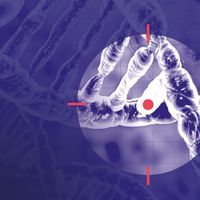ABOVE: ASTRAZENECA
One of the barriers to using CRISPR-Cas9 gene editing in the clinic is the possibility that the enzyme will clip DNA in the wrong spot. In a study published in Nature today (September 12), researchers describe a strategy to predict these off-target mutations throughout the genome and show in mice that a carefully designed guide RNA strand does not produce any detectable slip-ups.
The study confirms that “you’d better make sure that you’ve got a really accurate guide RNA,” says Janet Rossant, a developmental biologist at the University of Toronto and the Hospital for Sick Children who did not participate in the work. “This [method] is a better way of testing for how specific that guide RNA will be before you go into animal models and, of course, into humans,” she adds.
According to coauthor Marcello Maresca, a biologist at AstraZeneca in Sweden,...
Off-target cuts can happen in a genomic location where they have no effect on an organism, or they can disrupt essential cellular functions. When trying to anticipate the spots where Cas9 might go wrong, researchers often start with computational predictions, but these rely on assumptions about how their guide RNA will bind DNA and how Cas9 cuts.
See “New Methods to Detect CRISPR Off-Target Mutations”
“It’s exciting to see a method for experimentally defining off targets, as this approach lacks the bias introduced by our assumptions about what constitutes a likely off target,” says Kate O’Connor-Giles, a neuroscientist at Brown University who did not participate in the study.
To develop a method of minimizing off-target effects, Maresca’s group joined forces with the team of J. Keith Joung, a biologist and pathologist at Harvard University and Massachusetts General Hospital. The first part of the researchers’ approach—originally developed by Joung’s group and published in 2017—happens in vitro. First, they shear genomic DNA—in the current study they used mouse genomes—into chunks of about 300 base pairs and then attach a series of adapters that circularize the DNA. They introduce a Cas9 nuclease and guide RNA complex, which cleaves the circular DNA at some spots, linearizing it.
It provides a way for you to be able to assess whether changes that you make to a strategy to improve specificity have the intended effect.
—J. Keith Joung, Harvard University
Another batch of nucleases degrades the remaining circular DNA that didn’t get sliced up. In this way, the researchers can sequence the linearized DNA to see where the Cas9 made its cuts—both intended and unintended—and predict whether that guide RNA will lead to off-target effects in vivo.
For part two of the strategy developed in the latest study, the authors tested their prediction in mice. When they used a guide RNA that they found in vitro would snip thousands of wrong spots in the genome, more than 40 percent of the predicted sites of the subset that they checked were also mutated in mouse livers. The more often that a site came up in their in vitro screen, the more likely it was to be mutated in vivo. In other words, the guide RNA that was sloppy in vitro was also sloppy in vivo.
The team also checked spots in the mouse genome from the in vivo experiments that were computationally predicted as possible off-target sites yet didn’t show up in their in vitro screen. They didn’t detect mutations at these locations, meaning that their in vitro method likely did not miss true off targets.
For another guide RNA that the researchers expected to be highly specific to the target site, they identified no detectable mutations in vivo at any of the 182 predicted sites.
“A real advance is the practical ability to detect organism-specific off targets, rather than relying on a reference genome sequence that doesn’t necessarily reflect the genetic context of the organism you’re working with or, in the case of a clinical setting, the patient,” says O’Connor-Giles. Because it’s possible to use genomic DNA from the specific patient or organism to screen in vitro, the reads from the sequencing step reflect the possible Cas9 targets in the genome of the subject.
“This [study] should encourage the further development of in vivo based therapeutics,” says Joung. “It also provides an important blueprint or pathway forward for how one can look at these potential off targets in the context of a whole organism or an in vivo setting. And that's important because—especially for research purposes—it provides a way for you to be able to assess whether changes that you make to a strategy to improve specificity have the intended effect.”
P. Ackakaya et al., “In vivo CRISPR editing with no detectable genome-wide off-target mutations,” Nature, doi:10.1038/s41586-018-0500-9, 2018.
Interested in reading more?







